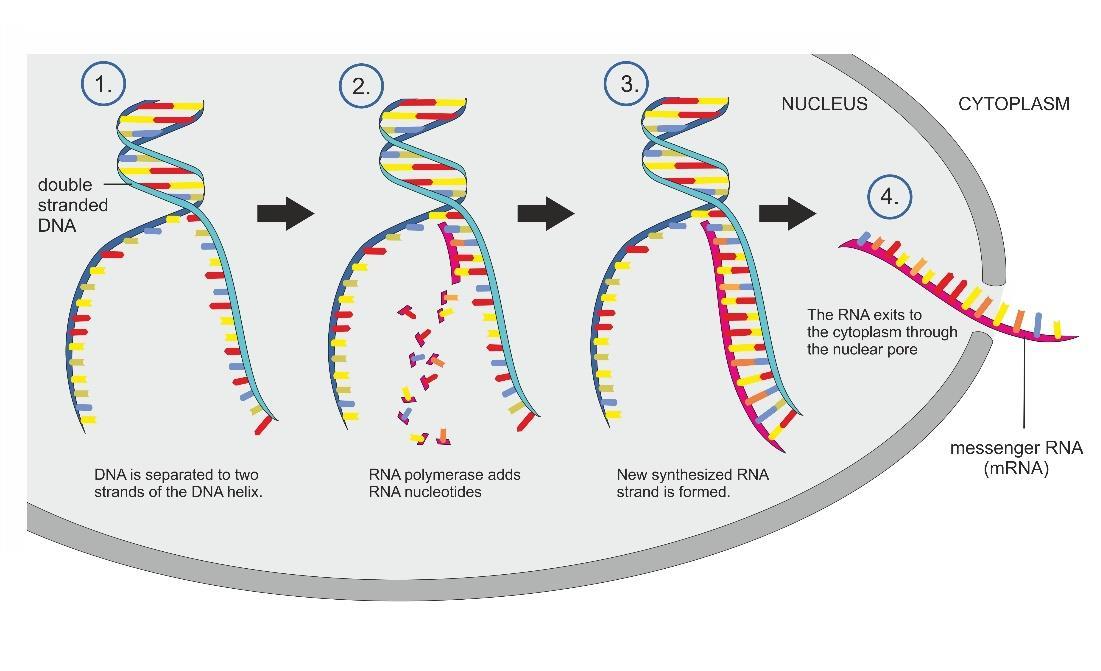
4 minute read
Transcription, Replication, and Translation
information in the genes of the DNA happens by transcribing the coordinating RNA nucleotide on a base-by-base basis until the entire gene is transcribed with the right mRNA strand.
The mRNA that is produced is usually pre-mRNA that needs to undergo a transformation to mature into mRNA that can go to the ribosomes to translate the message into proteins in a process known as translation. This may make a complete protein, a pre-protein that needs modification, or a subunit of a much larger protein complex that needs other subunits to make a complete protein. Alternatively, replication can happen to a sequence of DNA when a cell is about to divide. This results in the copying of an entire chromosome so that it can go into making another cell that has the same set of DNA in the two copied cells. This process requires DNA polymerase and telomerase in order to copy the entire DNA sequence.
Advertisement
Genomic DNA is tightly packed in a form called DNA condensation. This allows the chromatin to fit into the very small nucleus inside the cell. Only small amounts of DNA are located outside of the nucleus, such as in the mitochondria in animal cells and chloroplasts in plant cells. The total set of DNA in a cell is called its genotype, while the actual features of the person that occur as a result of the genotype is called the phenotype. This will be discussed further in other chapters of this course. The genes will contain an open reading frame that gets transcribed as well as a regulatory sequence that won’t get transcribed but will be promotor regions or enhancers, which control the rate of transcription of the open reading frame.
As mentioned, only a tiny fraction of DNA is actually encoded into a protein. In humans, less than 2 percent actually encodes for a protein. More than half of the DNA involves repetitive segments of non-coding DNA and accounts for the large differences in genome size or C-value. Some non-coding DNA segments will not code for proteins but will code for RNA segments that act to regulate gene expression and are never translated into a protein.
In addition, some noncoding DNA segments are important to the structure of the DNA. For example, both telomeres and centromeres are structural parts of the DNA and contain few or no genes but are important to the stability of the chromosome. A lot of noncoding DNA material are called “pseudogenes” because they are actually copies of genes that have been mutated and are therefore disabled. They can further mutate into active genes through divergence and the process of gene duplication.
As you already know, a gene sequence that contains genetic information can influence a host’s phenotype by making a strand of messenger RNA that ultimately gets translated into a functional protein. The relationship between the bases and the amino acids happens by means of codons, which are three-base-long segments of DNA that code for a specific protein. There is
a total of 64 possible codons so that some codons do not code for an amino acid and some codons code for more than one amino acid (of which there are twenty to code for).
Transcription happens because of the action of RNA polymerase, which is the enzyme that codes for a section of mRNA or, more specifically, pre-mRNA that must go through some more modifications before it is mature enough to make a protein segment. The mRNA goes to make a protein in the ribosomes through the process of translation, which requires tRNA (the molecule that holds the amino acid that goes one-by-one onto the protein molecule). There are three stop codons on DNA that don’t code for anything but tell the mRNA to stop transcribing. These are TAA, TGA, and TAG codons.
Figure 5 shows DNA transcription schematically:
Figure 5
Replication occurs during cell division and is essential for the growth of an organism. During replication, the DNA segment completely copies itself into a double genome that goes to either side of the cell. The second genome made is ideally identical to the original chromosomal content but errors in replication can always occur. The goal is to have two daughter cells that are identical to one another after the cell splits in two. DNE replication requires the enzyme called DNA polymerase, which is responsible for making a second copy of DNA from the 5’ to the 3’ direction. There are different mechanisms in place to code the antiparallel strands of the double helix so that each cell contains a total copy of all the chromosomes of the cell.
There is naked DNA, also called extracellular DNA or eDNA. It is mainly released when a cell dies and is found in the extracellular spaces between the cells. It may provide nutrients to other cells or it may act as a buffer to keep the pH the same in the extracellular space. In certain




